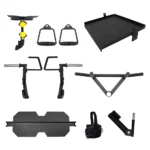Are you an active person like a runner or athlete and experiencing frequent lower leg pain? Everything from stinging shins to searing heels to sore and tender ankles may accompany frequent and repeated use of the legs, especially when you drastically increase running mileage or slope work in a short amount of time. Common causes of lower leg pain include:
Tendinitis
Tendons, or tough pieces of tissue which connect your muscles to your bones, can become strained, inflamed, and even torn by overuse or injury. Achilles tendinitis is a very common form of lower leg injury affected the tendon which runs down the back of the calf connecting to the heel bone. Swelling, pain, tenderness, and diminished leg strength accompany this type of lower leg injury which is often treated with rest, flexibility exercises, frequent icing, pronation checks, and avoiding strenuous hill work or speed increases when running.
Stress Fracture
When you do weight-bearing activities like running, a natural process of bone growth takes place – running stresses the bone leading to bone resorption and finally, the bone regenerates itself. When the bone regeneration process can?t keep up with the amount of stress to the bones, you end up with repeated microscopic fractures which build into a stress fracture.
Everything from your training schedule to your gender and even your diet can put you at risk for stress fractures. Typically stress fractures heal on their own once you have ceased high-impact activities and kept weight off the injured leg. Boots and casts can help stabilize the injured area, and a pair of crutches or a knee scooter can be a useful mobility aid for those with lower leg injuries like stress fractures.
Compartment Syndrome
Did you know that your muscles actually swell to a larger size when you exercise? The physical activity boosts blood flow to your muscles and initiates chemical reactions and fluid build-up, i.e. of lactic acid. When the layer of tissue surrounding your muscle compartments (the fascia) is too tight for the normal swelling response to take place it can cut off appropriate blood flow and constrict the nerve by your muscle. This results in pain, muscle weakness, and even numbness in the lower leg or foot. Symptoms may dissipate with inactivity as the swelling decreases, however, a proper diagnosis of chronic compartment syndrome is typically addressed with surgery.
Shin Splints
When the muscle attached to your inner tibia (shin bone) starts to incur microscopic tears and pulls away from the bone itself, you may experience pain, swelling, and tenderness known best as ?shin splints.? Common among novice runners, shin splints result from overuse, overpronation (exaggerated inward rolling of the ankle when you run), and frequently running on hard surfaces. Simple changes to your running surface, updating your running shoes, icing, and stretching exercises can help treat and prevent future shin splints.
Sprained Ankle
When the ligaments holding your ankle joint in place become overstretched, often by rolling, twisting, or awkwardly turning your ankle, this can result in a mild to severe sprain. A severe sprain will be accompanied by myriad symptoms including swelling, bruising, pain, tenderness, limited range of motion, weakness, and an inability to bear weight on the leg. A mild sprain, however, may feel tender, swollen, and stiff and simply like you tweaked your ankle.
If any type of ankle pain, mild or otherwise, sticks with you for several days, however, it?s best to seek a medical evaluation to prevent making an injury worse. Sprained ankles are typically healed with rest, joint exercises, ice therapy, bracing, and over-the-counter pain relievers.

Helen Bradley is a health blogger and the founder of her own blog about fitness. She has been blogging for three years now and loves to share what she learns with others. Helen enjoys reading, cooking, and staying active outdoors.











